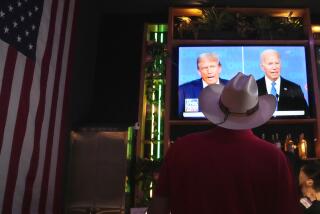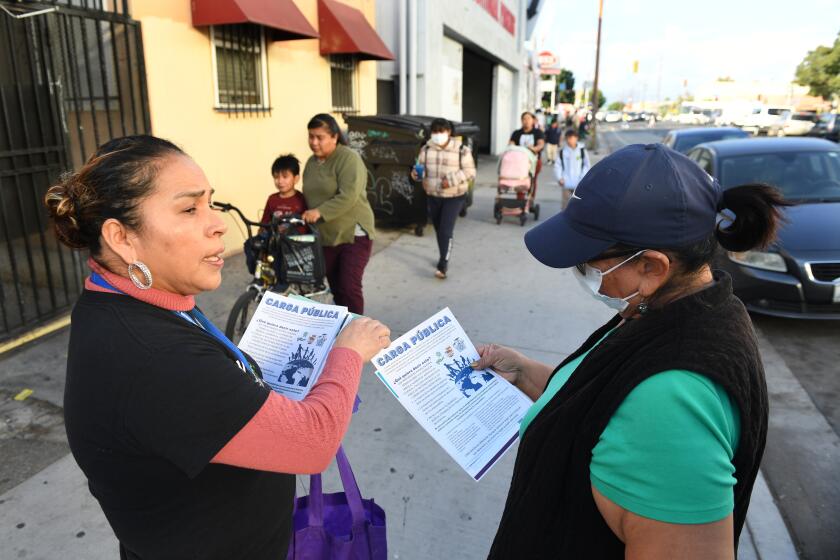Gore Asks Judge to Resume Count
- Share via
WASHINGTON — Whenever Vice President Al Gore sought to scare liberal Democratic audiences along the campaign trail, he would invoke the specter of an aggressively conservative Supreme Court led by Justice Antonin Scalia.
Now, Gore himself is facing just that prospect.
The justices met behind closed doors at the high court Saturday to begin work on a decision that could dash Gore’s fading hopes of becoming president. In his appeal to the court, Texas Gov. George W. Bush has asked the justices to bring “finality” to the election battle. If the five conservatives on the court stick together, they may be able to do just that.
Bush’s hopes brightened considerably midway through Friday’s argument, when Scalia laid out a new theory for overruling the liberal Florida Supreme Court, which had extended the deadline for counties to conduct vote recounts.
The Florida justices cited the state Constitution, among other things, in asserting their authority to alter election law. But Scalia pointed out that the U.S. Constitution empowers state lawmakers alone to set presidential election rules.
Laurence H. Tribe for Gore and Theodore B. Olson for Bush seemed caught off guard. Their back-and-forth legal briefs barely had mentioned the approach Scalia put forth.
The justices were fully prepared for verbal combat, however, probably because they had access before the hearing to a Scalia memo setting forth his views.
A former University of Chicago law professor, Scalia is the conservative theoretician of the high court. He regularly fires off lengthy memos to his colleagues on how they should decide issues ranging from property rights and the environment to the separation of powers and the principles for interpreting laws. (Rely on the plain words, not on what lawmakers said they intended to do, he says.)
In his 14 years as a justice, Scalia has written surprisingly few of the court’s major opinions. Often, he wants to go too far for his more moderate colleagues, ensuring that another justice will get to author the decision. He is best known for fiery dissents on such issues as abortion and gay rights.
Inside the court, however, Scalia has unusual influence, thanks to his memos. They are well researched, historically grounded and vigorously argued.
The Florida election case poses a problem for the court’s conservatives. The Florida Supreme Court, interpreting the state’s election laws, decided to waive the seven-day deadline for tallying votes and permitted hand recounts to continue. How could the U.S. Supreme Court intervene in such a case, since no federal law appeared to be at issue?
In his appeal on Bush’s behalf, Olson offered one theory. A 19th century federal election law--which is now in Title 3, Section 5 of the U.S. Code--says, in part, that presidential electors should be chosen based on “laws enacted prior to” election day. The justices quickly voted to hear that claim.
On further examination, however, they discovered this law was intended to govern disputes over state electors that reached Congress. When Olson pressed his argument Friday, he ran into skeptical questioning.
But when Tribe rose to defend the Florida Supreme Court, Scalia and Chief Justice William H. Rehnquist challenged him with a different argument.
The liberal state judges went wrong, they said, by invoking their own state constitution to void clear election rules set by the state Legislature. Article II of the U.S. Constitution says state lawmakers have complete power to set the rules for presidential elections, they said.
It is “a real problem, it seems to me, under Article II,” Scalia said, if the state judges rewrite the rules for choosing presidential electors.
When the oral argument came to an end, the five conservative justices had a straightforward theory that would allow them to rule for Bush.
However, doing so could tarnish the reputation of the justices, said some legal experts, especially if they rely on 19th century precedents that say the American voters have no constitutional right to elect their president.
“It was a real surprise. An argument that was not put forth by the Bush folks suddenly takes command,” said Columbia University law professor Samuel Issacharoff, an expert on voting rights. “Once Scalia raised it, the other justices seemed to swing toward it. This looked to be a tremendously uphill fight for Bush’s lawyers. But this way gives the court a narrow way to rule for them.”
Pepperdine University law professor Douglas Kmiec agreed that Friday’s argument went well for Bush’s side but said the outcome still looks to be very close.
“It seems to me the Florida Supreme Court may have brought this problem on themselves. Thinking this to be an ordinary case, they deliberately did not refer to federal law . . . and did not refer to the federal Constitution at all,” said Kmiec, who headed the Justice Department’s office of legal counsel during the Reagan administration and is advising the Bush legal team.
In the last decade, liberal state courts have learned they can avoid being overruled by the conservative U.S. Supreme Court if they ground their opinions in their state constitution. Usually, that approach succeeds.
It may not work this time, Kmiec noted, because this is a presidential election, and Article II of the U.S. Constitution allows state legislatures to set the rules.
But if Scalia’s approach gives the conservatives a way to prevail, it also may contain the seeds of a public relations disaster for the high court. Not only would a 5-4 ruling for Bush be seen as partisan but the court’s opinion also would be read as saying American voters have no right to elect a president, a Duke University historian said Saturday.
“Stepping back from the technicalities, Scalia is saying that there’s an anti-democratic thrust to Article II of the Constitution,” said professor Alexander Keyssar, author of “The Right to Vote: The Contested History of Democracy in the United States.”
This section of the original Constitution gives power to the state legislatures and the electoral college, “and, in effect, it leaves out the people. If you follow the logic through, the implication is we have no guarantee of a right to vote in presidential elections, which is astonishing,” Keyssar said.
Undeterred by such concerns, Scalia made just that blunt point during Friday’s argument.
“There’s no right to suffrage under Article II,” he told Tribe, so states are free to limit not only recounts of votes but voting itself.
Indeed, neither the original U.S. Constitution nor the current version contains an explicit right to vote for president. Since the Civil War, several amendments to the Constitution have expanded the right to vote. But they are all phrased in the negative--such as the 19th Amendment, which says that the right to vote “shall not be denied or abridged . . . on account of sex”--rather than a general affirmation of a right.
According to Keyssar, the last time there was an effort to explicitly enact an overall federal law on the issue came in 1963, when two members of Congress introduced a proposal “to establish a free and universal franchise throughout the United States.” The measure went nowhere. However two years later, at the height of the civil rights era, Congress enacted the Voting Rights Act of 1965--designed to end literacy tests and other devices that had been used in the South for years to keep blacks from voting. Numerous state constitutions--including Florida’s--contain more explicit, sweeping language about the right to vote in general than the U.S. Constitution does.
In the past, Scalia’s relentless legal logic has turned away some of his colleagues--including several who are quite conservative themselves.
Because of the extraordinary dimension to the Florida case, many Supreme Court watchers think the more cautious conservatives will step back and counsel against a quick or decisive ruling.
“It amazes me the number of people who think it will be 5-4. I can’t imagine the court wants to do that,” said Stanford University law professor Pamela Karlan, who clerked for Justice Harry A. Blackmun in the mid-1980s.
“A divided opinion along political lines would not be a great moment for the Supreme Court,” Issacharoff added.
But if not that, then what will happen?
“I am baffled as to what they will do unless they blur things,” Karlan said.
Indeed, some legal observers said they think it is possible that the court could say that the case is not ripe for a decision on technical grounds. USC law professor Erwin Chemerinsky said he thinks that “there is a lot of sense to that approach.” However, he also said that he thinks Rehnquist will be reluctant to walk away from the case because he “is so conscious of the court’s historic role.”
Before the oral argument, many legal observers said they hoped that the court could come to a unanimous verdict that would help quell the divisiveness that has surrounded the election and its prolonged aftermath. But after the argument, most observers said they thought that an unlikely prospect because of apparently sharp splits among the justices that emerged Friday.
“There has been a lot of discussion on the institutional imperative of the court to reach unanimity,” said New York University law professor Richard Pildes. However, he said the “extreme time pressure” the court appears to be operating under does not afford it the ability “to go through the process out of which unanimity is forged.”
Pildes predicted that whatever the court does is “not likely to be of major legal significance” because the ruling would not determine the independent legal challenge Gore has pending in Florida state courts. However, many political observers believe that if Gore loses at the U.S. Supreme Court, it will increase the pressure on him to concede.
(BEGIN TEXT OF INFOBOX / INFOGRAPHIC)
Who Appointed the Justices
The nine Supreme Court justices are appointed to life terms by the president and approved by the Senate. The Supreme Court term lasts from October until late June or early July. About 6,500 cases a year are on the court’s docket, but justices usually hear oral arguments in only about 100.
*
RICHARD NIXON (1969-74)
1972: William H. Rehnquist
*
GERALD R. FORD (1974-77)
1975: John Paul Stevens
*
JIMMY CARTER (1977-81)
No justice appointments
*
RONALD REAGAN (1981-89)
1981: Sandra Day O’Connor
1986: Antonin Scalia
1988: Anthony M. Kennedy
*
GEORGE BUSH (1989-93)
1990: David H. Souter
1991: Clarence Thomas
*
BILL CLINTON (1993-2001)
1993: Ruth Bader Ginsburg
1994: Stephen G. BreyerSources: U.S. Supreme Court; Times staff reports
More to Read
Get the L.A. Times Politics newsletter
Deeply reported insights into legislation, politics and policy from Sacramento, Washington and beyond. In your inbox twice per week.
You may occasionally receive promotional content from the Los Angeles Times.











